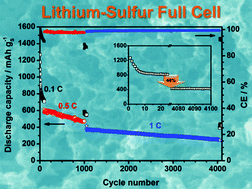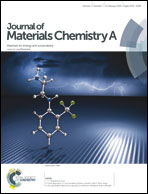A lithium–sulfur full cell with ultralong cycle life: influence of cathode structure and polysulfide additive†
Abstract
Lithium–sulfur batteries are highly attractive energy storage systems, but suffer from structural anode and cathode degradation, capacity fade and fast cell failure (dry out). To address these issues, a carbide-derived carbon (DUT-107) featuring a high surface area (2088 m2 g−1), high total pore volume (3.17 cm3 g−1) and hierarchical micro-, meso- and macropore structure is applied as a rigid scaffold for sulfur infiltration. The DUT-107/S cathodes combine excellent mechanical stability and high initial capacities (1098–1208 mA h gS−1) with high sulfur content (69.7 wt% per total electrode) and loading (2.3–2.9 mgS cm−2). Derived from the effect of the electrolyte-to-sulfur ratio on capacity retention and cyclability, conducting salt is substituted by polysulfide additive for reduced polysulfide leakage and capacity stabilization. Moreover, in a full cell model system using a prelithiated hard carbon anode, the performance of DUT-107/S cathodes is demonstrated over 4100 cycles (final capacity of 422 mA h gS−1) with a very low capacity decay of 0.0118% per cycle. Application of PS additive further boosts the performance (final capacity of 554 mA h gS−1), although a slightly higher decay of 0.0125% per cycle is observed.


 Please wait while we load your content...
Please wait while we load your content...